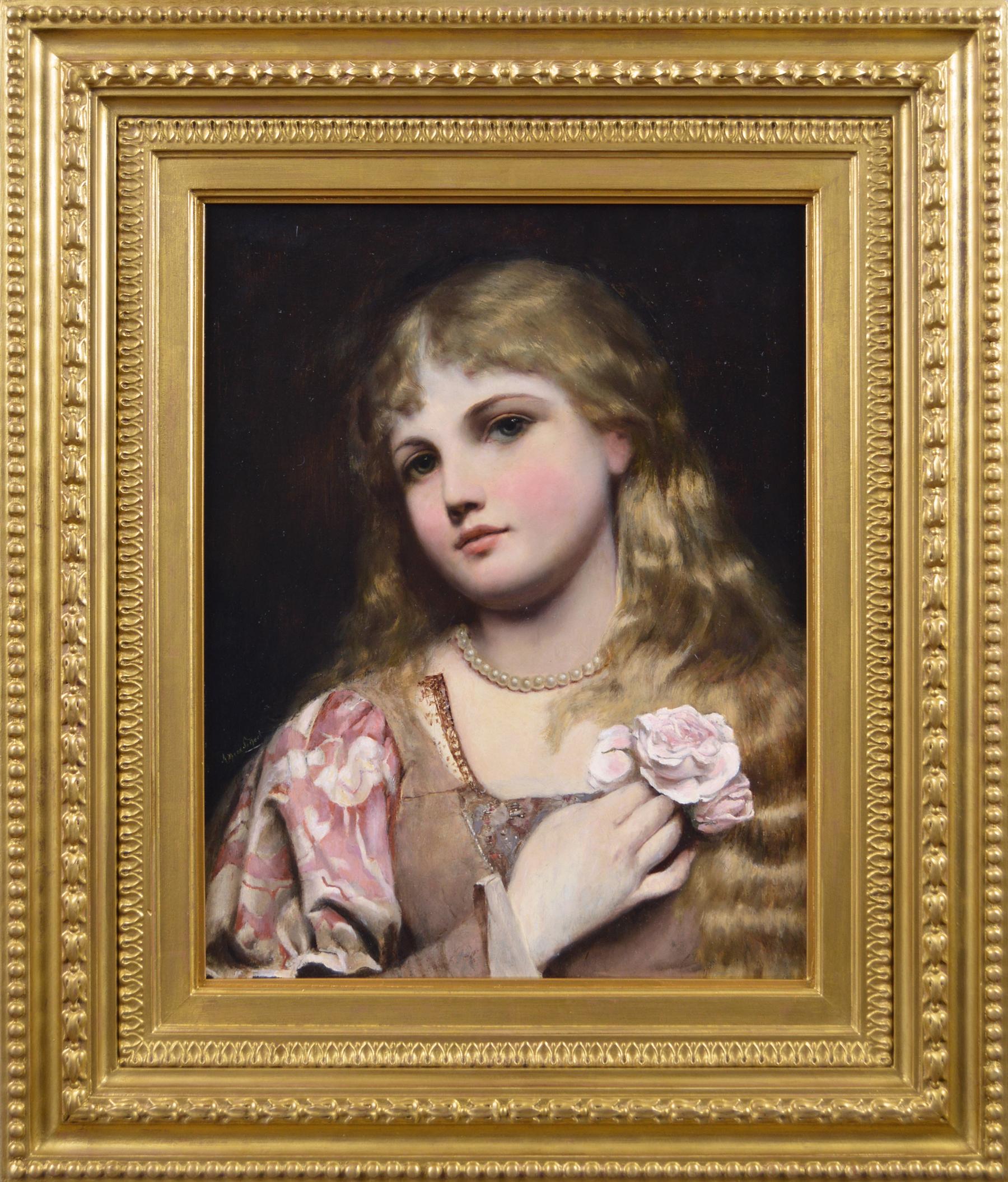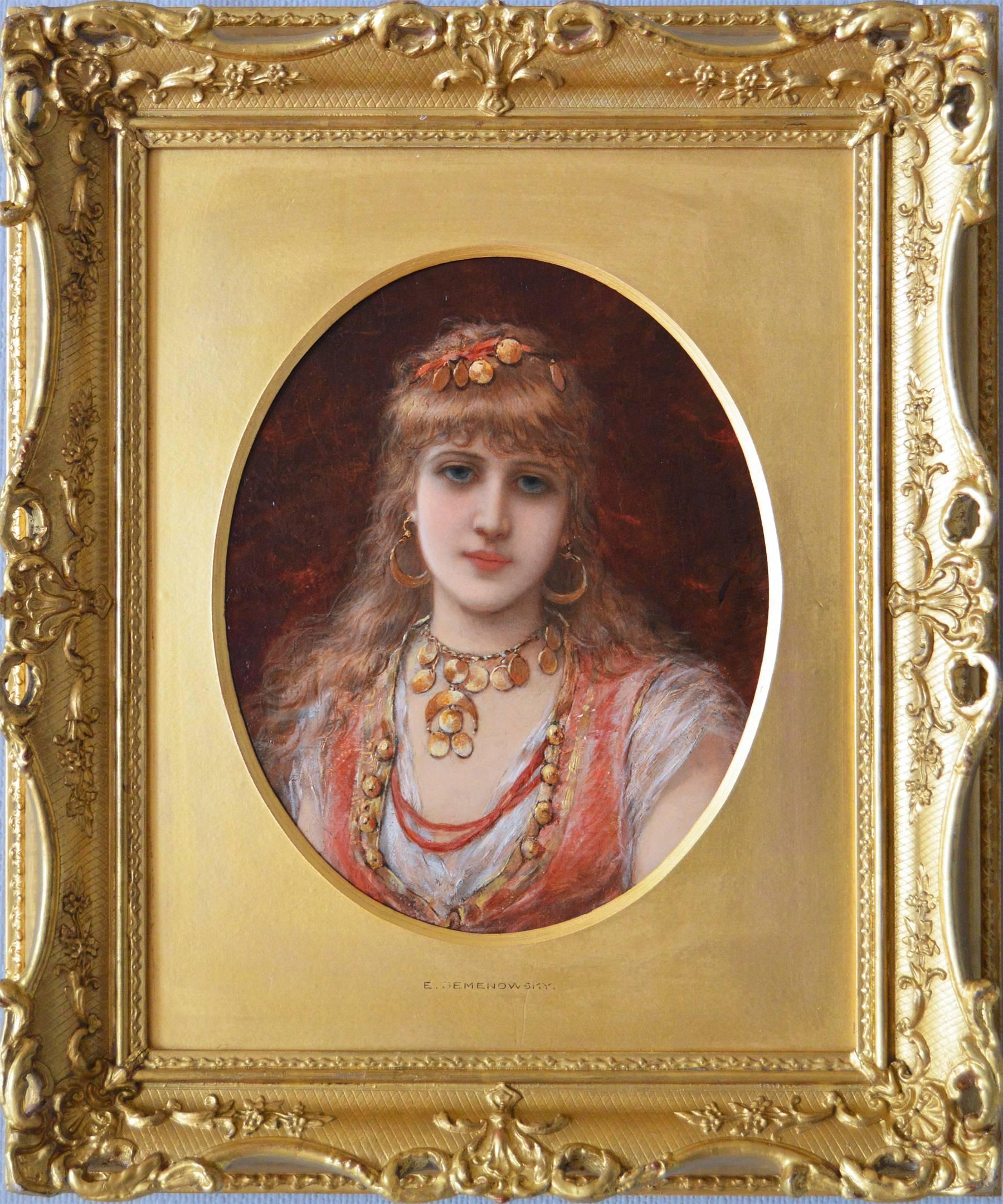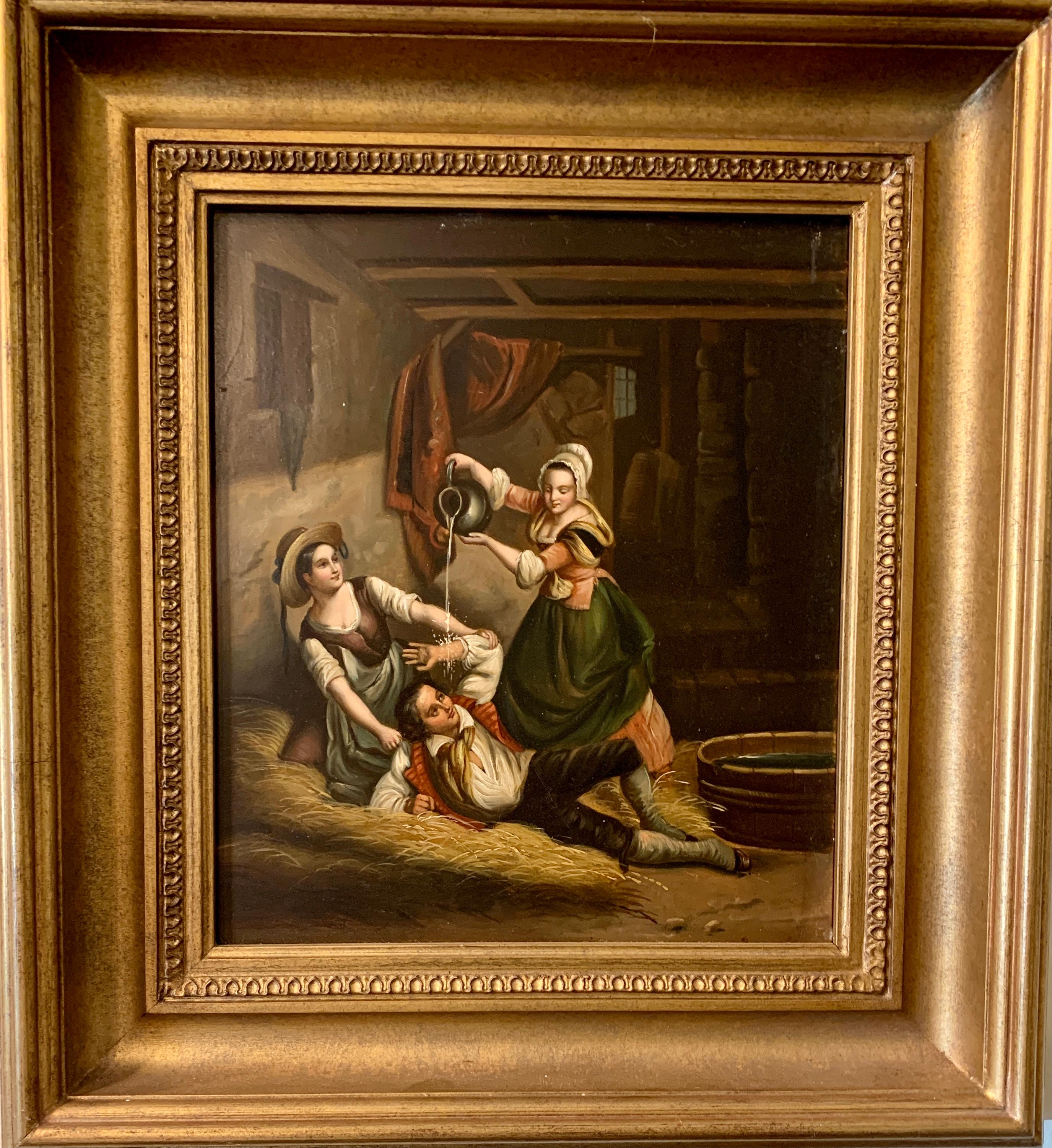Items Similar to Portrait of a Mary Hardy (nee Sulman), Late 19th Century Victorian Oil
Want more images or videos?
Request additional images or videos from the seller
1 of 3
UnknownPortrait of a Mary Hardy (nee Sulman), Late 19th Century Victorian Oil
About the Item
Slade School
Late 19th Century
Portrait of a Mary Hardy (nee Sulman)
Oil on panel
Image size: 8 x 7 inches
Contemporary frame
Provenance
Lady Town (Granddaughter)
Philip A Town
On the back of the wooden panel it says "Mary Sulman painted by a fellow student at the Slade School"
Source Lady C.M. Town her granddaughter.
Students entering the Slade began by drawing from the Antique in the cast room until judged competent to progress to the life room. Life drawing was the most important component of the Slade curriculum. Models sat in the life room every day and the students spent the majority of their time drawing from life and draped models, progressing to painting from the model when judged sufficiently advanced. Composition subjects were set by the Slade Professor once a month and there were lectures on anatomy and perspective.
Outside the formal classes, students were also encouraged to study the Old Masters at the National Gallery and British Museum and to contribute to the monthly ‘Sketch Club’ for which composition titles were set.3 Each year, prizes were awarded for figure composition painting (the Summer Composition Competition), figure painting, head painting, figure drawing, antique drawing, sculpture and fine-art anatomy
- Dimensions:Height: 8 in (20.32 cm)Width: 7 in (17.78 cm)
- Medium:
- Movement & Style:
- Period:
- Condition:
- Gallery Location:London, GB
- Reference Number:1stDibs: LU5246879532
About the Seller
5.0
Vetted Seller
These experienced sellers undergo a comprehensive evaluation by our team of in-house experts.
Established in 2007
1stDibs seller since 2014
63 sales on 1stDibs
Typical response time: 4 hours
- ShippingRetrieving quote...Ships From: London, United Kingdom
- Return PolicyA return for this item may be initiated within 14 days of delivery.
More From This SellerView All
- UnaLocated in London, GBRichard Waller 1811 - 1882 Una Oil on canvas, signed lower right and dated 1879 Image size: 23 1/2 x 19 1/2 inches (59.5 x 49.5 cm) Original frame Una is one of the main characters in the first book of Edmund Spenser...Category
19th Century Victorian Portrait Paintings
MaterialsOil, Canvas
- Portrait of Miss Tonks, Signed and dated 19th Century OilLocated in London, GBOil on canvas, signed and dated lower right 1882 Image size: 36 x 29 inches (92 x 74 cm) Gilt Watts frame LITERATURE The Life and Work of Frank Holl, Ada ...Category
19th Century Victorian Portrait Paintings
MaterialsOil, Canvas
- Portrait of a Girl with Book, 18th Century Regency Oil PaintingLocated in London, GBOil on canvas Image size: 28 3/4 x 24 inches (73 x 61 cm) Contemporary style gilt frame This portrait is an evocative example of Devis' Regency period portraiture, featuring a pleasant looking young girl holding a book in an outdoor setting. Working with a darker palette, a strongly accented diagonal recession, and dramatic contrasts of light and shadow, Devis heightens the girl's three-dimensional physical presence in the foreground of the composition. The Artist Arthur William Devis (10 August 1762 – 11 February 1822) was an English painter of history paintings and portraits. He painted portraits and historical subjects, sixty-five of which he exhibited (1779–1821) at the Royal Academy. Among his more famous works are a depiction of the Death of Nelson and a posthumous portrait of Nelson. Devis was born in London, the nineteenth child of the artist Arthur Devis and his wife Elizabeth Faulkner. Devis was the younger brother of the painter Thomas Anthony Devis (1757–1810) and of the schoolmistress and grammarian Ellin Devis (1746–1820), teacher, among others, of author of Maria Edgeworth and Frances Burney (later novelist Madame d'Arblay). He followed his elder brother Thomas Anthony in becoming a pupil at the Royal Academy Schools in 1774 and like his brother exhibited at the Free Society of Artists, of which in 1768 their father had become president, and at the Royal Academy. Early on he came to the notice of Sir Joshua Reynolds. He was appointed draughtsman on the British East India Company's packet Antelope in a voyage in 1783, under Captain Henry Wilson. In her he was injured in an encounter with Papuans near the Schouten Islands and was then wrecked on the Pelew Islands before proceeding to Canton and thence to Bengal. During his voyages, the artist received arrow wounds, one of which inflicted permanent injury on his lower jaw. During his time in Bengal, he painted a portrait of Sir William Jones, at the time a judge in Fort William. The painting now hangs at the British Library. He was back in London by 1795 and is recorded on 21 July 1797 as living at 27 George Street, Hanover Square, where he was insured by the Sun Assurance Office. He is noted for his involvement in the creation of the posthumous cult of Horatio Nelson. As she returned from Trafalgar, Devis went out to meet HMS Victory and was present on board the ship during the autopsy of Nelson's body conducted by Dr Beatty, the ship's surgeon. With the help of sketches he took at that time, he painted a heroic Death of Nelson, which proved a sensation. Devis also painted Dr Beatty, and was commissioned by him to produce a half-length painting of Nelson as vice-admiral, which he lent to Emma Hamilton (who later lost it in an accident whilst travelling). Either the original or a copy of this portrait was exhibited at the Royal Academy two years after the Battle and many copies were made of it. Lord Howe owned one, and another ended up in the collection of the National Maritime Museum. It also appeared as an engraving in Beatty's published account of Nelson's death. Other work includes a portrait of King George III on horseback, and a range of portraits of admirals and generals, along with historical subjects, such as the Babington Plot and the signing of the Magna Carta...Category
18th Century Victorian Portrait Paintings
MaterialsOil, Canvas
- Portrait of Herbert Fisher, Mid-19th Century Oil Painting, Original Watts FrameBy George Frederic WattsLocated in London, GBOil on canvas c.1855 - 1860 Image size: 19 x 14 inches (48.25 x 37.25 cm) Original Watts frame The Sitter Herbert William Fisher (1826 - 1903) was a British historian, best known for his 'Considerations on the Origin of the American War' (1865). Fisher was tutor to the future King Edward VII, and served as Private Secretary to the 5th Duke of Newcastle. in 1863 he became Private Secretary to the Prince of Wales, his former pupil, before being appointed to the position of Vice-Warden of the Stannaries in 1870. One of his daughters, Adeline, married Ralph Vaughan Williams. George Frederick Watts Watts (1817 - 1904) was a British painter and sculptor associated with the Symbolist movement. He is known to have said 'I paint ideas, not things'. Watts became famous in his lifetime for his allegorical works, such as 'Hope' and 'Love and Life' in which the emotions and aspiration life were intended to be represented in a universal symbolic language. Watts was born in Marylebone in central London on the birthday of George Frederic Handel (after whom he was named), to the second wife of a poor piano-maker. He showed artistic promise very early, learning sculpture from the age of 10 with William Behnes, starting to study devotedly the Elgin Marbles (later writing "It was from them alone that I learned") and then enrolling as a student at the Royal Academy Schools at the age of 18. He first exhibited at the Academy in 1837, with a picture of "The Wounded Heron" and two portraits, but his attendance at the Academy was short-lived, and his further art education was confined to personal experiment and endeavour, guided by a constant appeal to the standard of ancient Greek sculpture. He also began his portraiture career, receiving patronage from his close contemporary Alexander Constantine Ionides, who later came to be a close friend. In 1849 the first two of the allegorical compositions which form the most characteristic of the artist's productions were exhibited—"Life's Illusions," an elaborate presentment of the vanity of human desires, and "The people that sat in darkness," turning eagerly towards the growing dawn. In 1850 he first gave public expression to his intense longing to improve the condition of humanity in the picture of "The Good Samaritan" bending over the wounded traveller; this, as recorded in the catalogue of the Royal Academy, was "painted as an expression of the artist's admiration and respect for the noble philanthropy of Thomas Wright, of Manchester," and to that city he presented the work. From the late 1840s onward he painted many portraits in France and England, some of which are described below. Notable pictures of the same period are “Sir Galahad...Category
1850s Victorian Portrait Paintings
MaterialsCanvas, Oil
- Portrait of a Young GirlLocated in London, GBOil on board Image size: 14 x 11 1/4 inches (35.5 x 28.5 cm) Gilt frame This is a striking and well-executed oval half-length portrait of a girl sitting in an armchair in a brown dress and a black lace scarf...Category
19th Century Victorian Portrait Paintings
MaterialsOil, Board
- Portrait of William Herbert, 3rd Earl of Pembroke, Early 17th Century PortraitLocated in London, GBEnglish School, (circa 1600) Portrait of William Herbert, 3rd Earl of Pembroke Oil on panel, oval Image size: 29¼ x 23⅞ inches Painted wooden frame Provenance: 176, Collection of Francis Greville, 1st Earl of Warwick. The Trustees of the Lord Brooks’ Settlement, (removed from Warwick Castle). Sotheby’s, London, 22nd March 1968, lot 81. Painted onto wooden panel, this portrait shows a dark haired gentleman in profile sporting an open white shirt. On top of this garments is a richly detailed black cloak, decorated with gold thread and lined with a sumptuous crimson lining. With the red silk inside it’s all very expensive and would fall under sumptuary laws – so this is a nobleman of high degree. It’s melancholic air conforms to the contemporary popularity of this very human condition, evident in fashionable poetry and music of the period. In comparison to our own modern prejudices, melancholy was associated with creativity in this period. This portrait appeared in the earliest described list of pictures of Warwick castle dating to 1762. Compiled by collector and antiquary Sir William Musgrave ‘taken from the information of Lord & Lady Warwick’ (Add. MSS, 5726 fol. 3) is described; ‘8. Earl of Essex – an original by Zuccharo – seen in profile with black hair. Holding a black robe across his breast with his right hand.’ As tempting as it is to imagine that this is a portrait of Robert Devereux, the 2nd Earl Essex, we might take this with a pinch of salt. Its identification with this romantic and fatal Elizabethan might well have been an attempt to add romance to Warwick Castle’s walls. It doesn’t correspond all that well with Essex’s portraits around 1600 after his return from Cadiz. Notably, this picture was presumably hung not too far away from the castle’s two portraits of Queen Elizabeth I. The first, and undoubtedly the best, being the exquisite coronation portrait that was sold by Lord Brooke in the late 1970s and now hangs in the National Portrait Gallery. The second, described as being ‘a copy from the original at Ld Hydes’, has yet to resurface. The portrait eventually ended up being hung in the State Bedroom of Warwick Castle. Archival documents present one other interesting candidate. The Greville family’s earliest inventory of paintings, made in 1630 at their home Brooke House in Holborn, London, describes five portraits of identified figures. All five belonged to the courtier, politician and poet Sir Fulke Greville (1554-1628), 1st Baron Brooke, and were hung in the ‘Gallerie’ of Brooke House behind yellow curtains. One of them was described as being of ‘Lord of Pembrooke’, which is likely to have been William Herbert (1580-1630), 3rd Earl of Pembroke. William was the eldest son of Greville’s best friend’s sister Mary Sidney, and was brought up in the particularly literary and poetically orientated household which his mother had supported. Notably, the 3rd Earl was one of the figures that Shakespeare’s first folio was dedicated to in 1623. The melancholic air to the portrait corresponds to William’s own pretensions as a learned and poetic figure. The richness of the robe in the painting, sporting golden thread and a spotted black fabric, is indicative of wealth beyond that of a simple poet or actor. The portrait’s dating to around the year 1600 might have coincided with William’s father death and his own rise to the Pembroke Earldom. This period of his life too was imbued with personal sadness, as an illicit affair with a Mary Fitton had resulted in a pregnancy and eventual banishment by Elizabeth I to Wilton after a short spell in Fleet Prison. His illegitimate son died shortly after being born. Despite being a close follower of the Earl of Essex, William had side-stepped supporting Devereux in the fatal uprising against the Queen and eventually regained favour at the court of the next monarch James I. His linen shirt is edged with a delicate border of lace and his black cloak is lined on the inside with sumptuous scarlet and richly decorated on the outside with gold braid and a pattern of embroidered black spots. Despite the richness of his clothes, William Herbert has been presented in a dishevelled state of semi-undress, his shirt unlaced far down his chest with the ties lying limply over his hand, indicating that he is in a state of distracted detachment. It has been suggested that the fashion for melancholy was rooted in an increase in self-consciousness and introspective reflection during the late 16th and early 17th centuries. In contemporary literature melancholy was said to be caused by a plenitude of the melancholy humor, one of the four vital humors, which were thought to regulate the functions of the body. An abundance of the melancholia humor was associated with a heightened creativity and intellectual ability and hence melancholy was linked to the notion of genius, as reflected in the work of the Oxford scholar Robert Burton, who in his work ‘The Anatomy of Melancholy’, described the Malcontent as ‘of all others [the]… most witty, [who] causeth many times divine ravishment, and a kind of enthusiamus… which stirreth them up to be excellent Philosophers, Poets and Prophets.’ (R. Burton, The Anatomy of Melancholy, London, 1621 in R. Strong, ‘Elizabethan Malady: Melancholy in Elizabethan and Jacobean Portraits’, Apollo, LXXIX, 1964). Melancholy was viewed as a highly fashionable affliction under Elizabeth I, and her successor James I, and a dejected demeanour was adopted by wealthy young men, often presenting themselves as scholars or despondent lovers, as reflected in the portraiture and literature from this period. Although the sitter in this portrait is, as yet, unidentified, it seems probable that he was a nobleman with literary or artistic ambitions, following in the same vain as such famous figures as the aristocratic poet and dramatist, Edward de Vere...Category
Early 17th Century Old Masters Portrait Paintings
MaterialsWood Panel, Oil
You May Also Like
- Robert von Steiger (1856-1941) Portrait Dutch Officer A. v. Steiger 1884 HollandLocated in Meinisberg, CHJohann Ludwig Robert von Steiger (Swiss, * 8th of January, 1856, Rio de Janeiro, Brazil; † 1st of June, 1941, Buenos Aires, Argentina) Portrait of Karl Alfred Arthur von Steiger Lie...Category
1880s Victorian Portrait Paintings
MaterialsWood Panel, Oil
- 19th Century portrait oil painting of a young woman with pearls & a roseBy Alfred SeifertLocated in Moreton-In-Marsh, GloucestershireAlfred Seifert Czech, (1850-1901) Portrait of a Young Woman with a Pearl Necklace & Rose Oil on panel, signed Image size: 15.5 inches x 12 inches Size including frame: 23 inches x...Category
19th Century Victorian Portrait Paintings
MaterialsOil, Panel
- 19th Century portrait oil painting of a young woman with a roseBy Alfred SeifertLocated in Moreton-In-Marsh, GloucestershireAlfred Seifert Czech, (1850-1901) Portrait of a Young Woman with a Rose Oil on panel, signed Image size: 10.5 inches x 8.25 inches Size including frame: 22 inches x 19.75 inches ...Category
19th Century Victorian Portrait Paintings
MaterialsOil, Panel
- 19th Century genre oil painting of a gentleman asleep at a tableLocated in Moreton-In-Marsh, GloucestershireHermann Armin Kern Hungarian (1839-1912) Siesta Oil on panel, signed, with wax seal to reverse Image size: 18.25 inches x 12.25 inches Size including frame: 23.75 inches x 17.75 inc...Category
19th Century Victorian Figurative Paintings
MaterialsOil, Panel
- 19th Century portrait oil painting of young womanBy Émile Eisman-SemenowskyLocated in Moreton-In-Marsh, GloucestershireÉmile Eisman-Semenowsky French/Polish, (1857-1911) Eastern Beauty Oil on panel, oval, signed & inscribed Paris Image size: 10.25 inches x 8.25 inches (oval) Size including frame: 18...Category
19th Century Victorian Portrait Paintings
MaterialsOil, Panel
- German oil painting, Figures in an interior/barn playing, 19th century, AntiqueLocated in Woodbury, CTWell painted late 19th-century German genre painting. Often painted in the Munich area of Germany these highly desirable antique paintings are always of the finest quality. This is...Category
1890s Victorian Figurative Paintings
MaterialsOil, Wood Panel
Recently Viewed
View AllMore Ways To Browse
A Late Victorian
Century Of Progress
Victorian Oil
Antique 19th Century Portrait
Old Victorian Art
Victorian Black Art
19th Century Antique Portrait Painting
Sculpture Head Portrait
Slade School
19th Century Antique Portraits Oil
Portrait Lady 19th
Formal Portrait Drawing
Anatomy Model
Framed 19th C Panel
Used Anatomy Models
Lady Mary
Antique Figure Drawing
Judge Portrait





